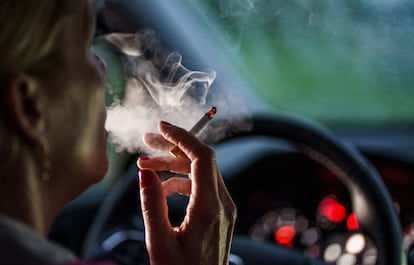Why you should never smoke in cars: ‘The concentration of carcinogens where children sit makes your hair stand on end’
Experts call for a ban on smoking in all automobiles after a study finds dangerous buildup of harmful compounds in smokers’ vehicles

Smoking kills. It kills the smoker and those around them. It destroys the health of everything in its path. Tobacco consumption causes the appearance of up to 16 types of cancer and is behind 80% of all lung tumors, as well as being a risk factor for other cardiovascular or respiratory conditions. And it not only harms the one holding the cigarette: the scientific community has confirmed that non-smokers who are exposed to tobacco smoke on a daily basis are up to 20% more likely to contract lung cancer and 25% more likely to experience a heart attack. Global public health guidelines have been dealing with smoking for years, ensuring smoke-free spaces such as schools, hospitals, restaurants and nightclubs, but there is one where they have not been able to make a difference: private cars. A recent study found a high concentration of nicotine and nitrosamines, the carcinogens in tobacco, in the air and on the surfaces of smokers’ vehicles. The exposure is short — the duration of a trip — but more intense, and it affects all occupants, experts warn.
The harmful potential of smoking makes no distinction between active or passive smokers, explains Esteve Fernández, head of the Tobacco Control Unit of the Catalan Institute of Oncology (ICO). “Passive exposure is bad for your health. We have known this since the 1990s,” he says. It increases the risk of lung cancer, heart attack and chronic obstructive pulmonary disease (COPD). It also exacerbates the symptoms of asthma. In children, it increases the risk of recurrent acute otitis, asthma and respiratory tract infections. “And there is another effect of passive smoking on pregnant women and fetuses: with passively exposed pregnant women, babies have a higher risk of being born with low birth weight and with a lower degree of lung maturation,” adds Fernández.
In closed, small places with little ventilation, the levels of exposure to environmental smoke — both from the burning of the cigarette and from what the smoker exhales — increase, and so do the risks. Fernández is one of the authors of a study coordinated by the Barcelona Public Health Agency and published in the Environmental Research journal in which they measure the concentrations of nicotine in the air, as well as the nitrosamines, the carcinogens in tobacco, in private vehicles in Spain and the United Kingdom. They also measured some compounds found in the dust settled on car surfaces. “It is a sporadic, brief exposure (between 15 minutes and one hour), but with concentrations six to 12 times higher than those that take place outdoors. It is a short, but intense and repetitive exposure. And it is cumulative,” warns Fernández. A 2011 study by this same researcher estimated that the prevalence of tobacco use in vehicles was 5.5%, and 2.2% of passengers under 14 years of age were exposed to secondhand smoke inside the vehicle.
In this new study, the Barcelona researchers measured, among other variables, the concentrations of nicotine, which is the addictive component of tobacco. The ICO expert clarifies that no one becomes addicted to nicotine as a passive smoker, “although in the case of ex-smokers, when they inhale tobacco smoke passively, all their memories awaken and there is a greater risk of them smoking again,” he adds. “We use nicotine because it is the best indicator that smoking has taken place, but also, the nicotine in the environmental smoke starts to oxidize when it comes into contact with the oxygen in the environment, becoming part of the specific nitrosamines of tobacco, which are the carcinogens that are produced when the tobacco in the cigarette burns and when the nicotine oxidizes,” explains the ICO researcher.
Nicotine and nitrosamine concentrations were much higher in the vehicles of people who smoked inside the car. And the car ventilation system does not eliminate second-hand smoke exposure, scientists warn. “When the car is running and you drive with the windows half open, the concentrations drop a little at the front, but they stay the same at the back. Where a child would be sitting, the concentration meter makes your hair stand on end,” states Fernández. Ana Navas-Acien, a researcher in the Department of Environmental Health Sciences at the Columbia University Mailman School of Public Health, agrees that opening the windows is not enough: “The car is a very small space and by smoking there, the polluted air becomes concentrated and people have less opportunity to avoid breathing that air with up to 50 carcinogens. Opening windows does not help because the air does not come out and these toxins are not eliminated.”
The danger of residual smoke
The worst thing is that all these particles remain in the car as a kind of reservoir for the pollutants of tobacco smoke. There is a residual smoke that does not go away, settled on fabrics and surfaces such as seats, or, in smokers’ homes, on curtains, fabrics, stuffed animals, carpets or the upholstery of the couch. “All the carcinogenic toxins stick to the upholstery of the car and, when you sit down, they come loose again and the person who gets into the car ends up inhaling them,” explains Francisco Pascual, member of the board of directors of Spain’s National Committee for the Prevention of Smoking. The Barcelona researchers found that the concentrations of all residual smoke compounds in cars whose drivers reported smoking inside were “up to six times those in non-smokers’ cars,” the study states.
The presence of this residual smoke on surfaces is particularly dangerous for children because they are more likely to touch everything and put their hands in their mouths, warns Navas-Acien, a White House cancer adviser. “Tobacco smoke has a large amount of toxins and if children are around, they will be breathing and assimilating all of this into their bodies,” emphasizes the researcher.
Fernández focuses on the risks of tobacco, but also warns that the use of electronic cigarettes inside the car is not free of danger. In another study, they showed that although there is less nicotine inside the smoker’s vehicle, there are also particles in suspension, such as fine particles (PM 2.5). “2.5 micron particles are very small, more than a lung cell, which is five or 10 microns. But these particles hit lung cells as if balls were being thrown at a car. This bombardment of particles has an inflammatory effect and can cause cardiovascular problems,” he explains. In addition, these components “can go through the bronchioles and spread throughout the body with the cargo they carry, such as nitrosamines or nicotine.”
The ICO researcher regrets that smoking inside private vehicles is not yet regulated in many countries. And to those who talk about freedom inside their private property, Pascual responds: “My freedom ends at your nose. The right to health has to be above other circumstances.” Fernández agrees: “When you are in a car, you cannot handle your phone, you cannot talk on the phone because you are threatening public safety. This is the same: you cannot smoke because it increases the accident rate and it is bad for everyone’s health. The right to public health trumps your individual right.”
Sign up for our weekly newsletter to get more English-language news coverage from EL PAÍS USA Edition
Tu suscripción se está usando en otro dispositivo
¿Quieres añadir otro usuario a tu suscripción?
Si continúas leyendo en este dispositivo, no se podrá leer en el otro.
FlechaTu suscripción se está usando en otro dispositivo y solo puedes acceder a EL PAÍS desde un dispositivo a la vez.
Si quieres compartir tu cuenta, cambia tu suscripción a la modalidad Premium, así podrás añadir otro usuario. Cada uno accederá con su propia cuenta de email, lo que os permitirá personalizar vuestra experiencia en EL PAÍS.
¿Tienes una suscripción de empresa? Accede aquí para contratar más cuentas.
En el caso de no saber quién está usando tu cuenta, te recomendamos cambiar tu contraseña aquí.
Si decides continuar compartiendo tu cuenta, este mensaje se mostrará en tu dispositivo y en el de la otra persona que está usando tu cuenta de forma indefinida, afectando a tu experiencia de lectura. Puedes consultar aquí los términos y condiciones de la suscripción digital.
More information
Archived In
Últimas noticias
Most viewed
- Oona Chaplin: ‘I told James Cameron that I was living in a treehouse and starting a permaculture project with a friend’
- Reinhard Genzel, Nobel laureate in physics: ‘One-minute videos will never give you the truth’
- Sinaloa Cartel war is taking its toll on Los Chapitos
- Why the price of coffee has skyrocketed: from Brazilian plantations to specialty coffee houses
- Silver prices are going crazy: This is what’s fueling the rally










































